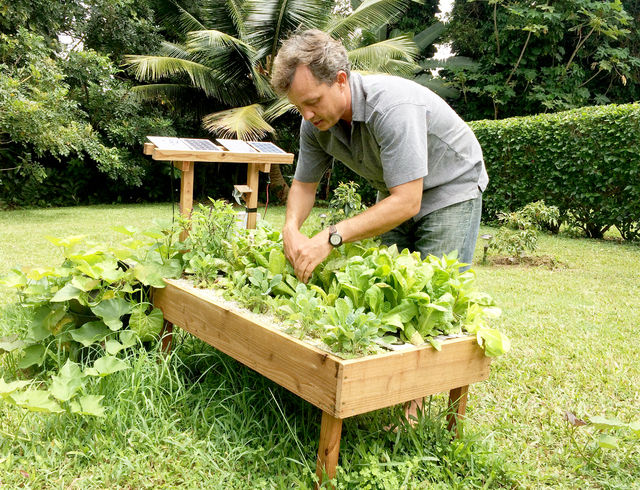PRINCEVILLE — James Brake was 220 pounds and suffering heart palpitations five years ago when he set out on a journey toward healthy eating. What he learned, aside from how good it can feel to swap a diet of French
PRINCEVILLE — James Brake was 220 pounds and suffering heart palpitations five years ago when he set out on a journey toward healthy eating.
What he learned, aside from how good it can feel to swap a diet of French fries and burritos with plant-based fuel, is that he doesn’t like digging.
No, gardening wasn’t his thing. But the high cost of organic produce got him down in the dirt anyway. Brake, who lives in Princeville with his wife and two daughters, took up a plot in the Malama Kauai Community Garden as a means of cutting down on his Foodland grocery bill and reinforcing his commitment to healthy eating.
But every time he and his family would fly to California to pay a visit to relatives, Brake would return to find his tomatoes and lettuce overrun with weeds.
Gardening wasn’t Brake’s thing, but even when he did try to tend to a bed of greens he simply couldn’t keep up.
One day he scratched his head and had a thought: If only I could enlist the help of a gardener robot to do the work for me.
Now, most people might have a thought like that and then move on. But not Brake. Leaning on his experience working as a software architect, he decided to make his vision of a robot gardener a reality. How hard could it be?
In fact, Brake had already been working on an automated permaculture kit in his back yard in California, where he lived before he and his family moved to Kauai. His healthy eating mission and subsequent gardening struggles only redoubled his desire to see the experiment through.
Five prototypes later, Brake has settled on a solar-powered garden robot the size of a coffee table capable of growing fresh, organic produce. The Growbot connects to the Internet, uses plant recognition technology to identify each plant, and adjusts the amount of nutrients it feeds the plants based what each species requires to flourish and how it’s currently doing.
Growbot takes photos of the plants — freckle lettuce, butter lettuce and carrots, in Brake’s case — and sends it the owner via a smartphone app so they can watch their garden grow remotely.
“The only thing you have to do on a regular basis is pick,” said Brake, pinching the lettuce that will make up his afternoon salad. “If you don’t pick, it gets crowded and if you don’t pick, you’ll have loss of growth.”
Despite it’s small size, Growbot is high yield. Brake said that it’s ideal for people who lack the space to cultivate their own traditional garden. All told, 60 to 80 plants can be grown in a Growbot, depending on what’s planted.
“This is for people who want to eat organic and want to eat local but don’t want to spend all their money on the food they eat — or their time,” said Brake, who is 43. “With my family, we just want to be safe with what we’re eating and economical.”
Growbot costs less than $1 a day in energy costs to operate, depending on what kind of fertilizer you decide to use, Brake said. (Brake uses a high-end blend of seaweed and manure).
And, when all is said and done, Brake said Growbot will be carbon negative. With each Growbot purchase, $10 will be donated to Trees for the Future, a non-profit that plants trees across the globe.
Growbot is ready for mass production. On Saturday, Brake and his team of marketers are launching a 30-day Indiegogo crowdfunding campaign with a goal of raising $100,000 to start production. The kickstarter campaign, and more information about Growbot, will be available at mygrowbot.com.
The fledgling company will also host a launch party at The General Store of Hanalei at 6 p.m. Saturday with pupus, music and, of course, a Growbot. Brake said he will be on hand to answer questions.
For a limited time, Brake said he plans to sell Growbots at an early-bird special price of $375. The retail price will later rise to $500.
But it won’t be Growbot’s financial success that brings its creator the most satisfaction.
“It’s easy to sell a robot as an impulse purchase but that’s not what I’m trying to do,” said Brake. “My goal is to make an effective difference in people’s lives. A real payday for me will be five years from now when we have this conversation and hear that this really changed things for them.”


